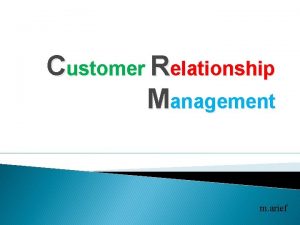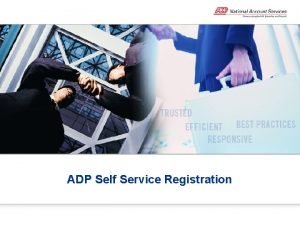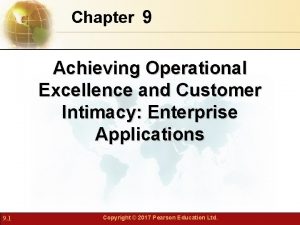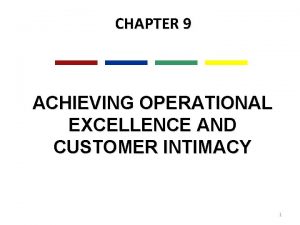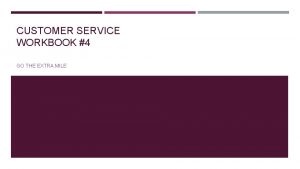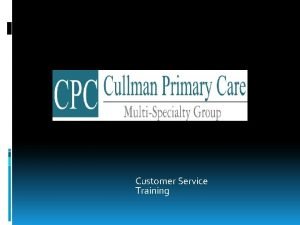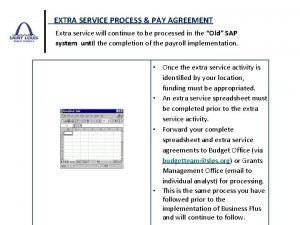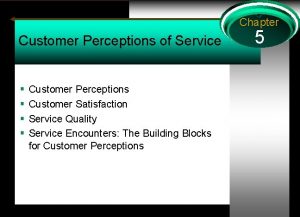CUSTOMER SERVICE CHAPTER 4 GO THE EXTRA MILE









- Slides: 9

CUSTOMER SERVICE CHAPTER #4 GO THE EXTRA MILE

CONDUCT CUSTOMER FOLLOW-UP Not every purchase requires follow-up. You should judge the situation and decide whether you need to follow up or not. Keep it professional. This is an effective way to make valuable contacts that may serve you in the future. Telephone message Consider the most appropriate time and place to call Leave a message if necessary Thank you cards Sending postcards to your best customers is a very effective and unobtrusive way to maintain your relationship, but be careful about postcards that others may read (gift purchase). Write a quick thank-you on store stationary or on the receipt.

USING BUSINESS CARDS ARTFULLY Your business card not only tells the customer who you are, but also tells him that you are serious about your work. Business cards provide a way for customers to contact you for future needs. If your company does not provide business cards, write your info on the back of sales receipts, special order forms, or note cards. Your business card should include the following: Your name, department, telephone extension, job title, company’s name, address, email, slogan (tagline), and logo (image) Additional tips: Write “Hope to see you at our anniversary sale!” on a flyer/ postcard, sign name and put it in bag. Write “Call if you have any questions” on the assembly instructions and add your name and phone number. Make your own business cards (if allowed by company policy)

BUSINESS CARD ETIQUETTE Keep it clean/neat. It is a reflection of you. Make sure it projects a professional image. No tears, folds, dirt, smudges. Always enclose your card in thank you cards or other customer correspondence. Don’t lead with your card (make sure customer has the card before leaving)

BUSINESS CARD ETIQUETTE Never ask for a customer’s business card unless you’ve offered your own card first. Some people don’t have any or uncomfortable using them for personal business. Only ask for a customer’s business card if it provides a direct benefit to the customer. In most cases, wait for the customer to offer it. Here are reasons to ask for the business card: Customer wants to know about the performance of a product and you need to research the information and get back to him. Remind him about an upcoming sale You are out of a specific item a customer wants and you offer to call him when a new shipment comes in. You cannot solve a customer’s problem, but offer to call him back if you find out another solution. An item is being altered or repaired or a part was ordered and you need to call the customer when it is ready or the part is available.

BUSINESS CARD ETIQUETTE Treat the card with respect. Use the back of the card to make notes about the customer’s preferences, special requests, etc. Make sure to ask the customer if you can use the number or email address.

MAINTAIN KEY INFORMATION ON CUSTOMERS Keep a client record/profile (a notepad, computer file, card file, folder, or binder) Basic records include the following Name, address, telephone, occupation (or hobbies, activities, projects, interests) Date and type of first purchase or contact. What did he buy? What was he shopping for? Preferences or specifications (size, color, label, brand name) Special considerations (allergies? Is the customer a traveler? A night shift worker? ) Does the customer prefer to have goods delivered, assembled, & serviced regularly?

MAINTAIN KEY INFORMATION ON CUSTOMERS Keep it up to date and review your lists regularly to take advantage of sales possibilities should new items arrive that match the customer’s particular interests. Keep the information confidential. Never share with anyone, even co-workers, without the customer’s permission. Confidential information include customer’s address, phone number, credit card numbers, sizes, times the customer is home for delivery, birth date, occupation, or place of business.

OFFER PERSONAL SHOPPER SERVICES Get to know your customer. This gives you an opportunity to know the customer and his/her shopping preferences to become a personal shopper. (I’m going on vacation to the beach, pick out some clothes for me”) Schedule personal shopper appointments with the customer: to show your customer what you have selected for him/her For shoppers who want your undivided attention For customers who have busy or odd schedules and are always in a hurry For customers who rely on you to help them with special gift purchases You may have to stay late or come in early to accommodate the customer. Check store policy before making appointments. Always keep records of your personal shopper appointments and what items were purchased or discussed. Keep appointments in a planner or calendar so you won’t miss them.
 Pengertian customer relationship
Pengertian customer relationship My adp self portal
My adp self portal Chapter 2 customer service
Chapter 2 customer service Using marketing information to gain customer insights
Using marketing information to gain customer insights Customer relationship management and customer intimacy
Customer relationship management and customer intimacy Beyond customer satisfaction
Beyond customer satisfaction Customer relationship management and customer intimacy
Customer relationship management and customer intimacy Customer relationship management and customer intimacy
Customer relationship management and customer intimacy Vertical name
Vertical name Extra credit chapter 15
Extra credit chapter 15
